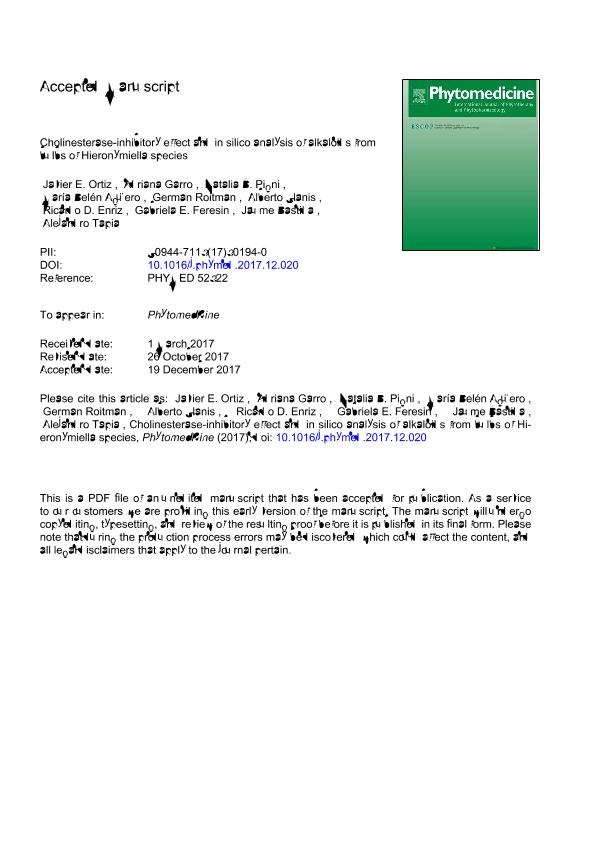Artículo
Cholinesterase-inhibitory effect and in silico analysis of alkaloids from bulbs of Hieronymiella species
Ortiz, Javier Esteban ; Garro, Adriana
; Garro, Adriana ; Pigni, Natalia Belen
; Pigni, Natalia Belen ; Agüero, María Belén
; Agüero, María Belén ; Roitman, Gustavo Germán; Slanis, Alberto Carlos; Enriz, Ricardo Daniel
; Roitman, Gustavo Germán; Slanis, Alberto Carlos; Enriz, Ricardo Daniel ; Feresin, Gabriela Egly
; Feresin, Gabriela Egly ; Bastida, Jaume; Tapia, Aníbal Alejandro
; Bastida, Jaume; Tapia, Aníbal Alejandro
 ; Garro, Adriana
; Garro, Adriana ; Pigni, Natalia Belen
; Pigni, Natalia Belen ; Agüero, María Belén
; Agüero, María Belén ; Roitman, Gustavo Germán; Slanis, Alberto Carlos; Enriz, Ricardo Daniel
; Roitman, Gustavo Germán; Slanis, Alberto Carlos; Enriz, Ricardo Daniel ; Feresin, Gabriela Egly
; Feresin, Gabriela Egly ; Bastida, Jaume; Tapia, Aníbal Alejandro
; Bastida, Jaume; Tapia, Aníbal Alejandro
Fecha de publicación:
01/2018
Editorial:
Elsevier Gmbh
Revista:
Phytomedicine
ISSN:
0944-7113
Idioma:
Inglés
Tipo de recurso:
Artículo publicado
Clasificación temática:
Resumen
Background In Argentina, the Amaryllidaceae family (59 species) comprises a wide variety of genera, only a few species have been investigated as a potential source of cholinesterases inhibitors to treat Alzheimer disease (AD). Purpose To study the acetylcholinesterase (AChE) and butyrylcholinesterase (BChE) inhibitory activities of the basic dichloromethane extracts (E) from Hieronymiella aurea, H. caletensis, H. clidanthoides, H. marginata, and H. speciosa species, as well as the isolated compounds from these plant extracts. Study design and methods AChE and BChE inhibitory activities were evaluated with the Ellman's spectrophotometric method. The alkaloids composition from the E was obtained by gas chromatography-mass spectrometry (GC-MS). The E were successively chromatographed on a silica gel column and permeated on Sephadex LH-20 column to afford the main alkaloids identified by means of spectroscopic data. Additionally, an in silico study was carried out. Results Nine known alkaloids were isolated from the E of five Hieronymiella species. Galanthamine was identified in all the species by GC-MS standing out H. caletensis with a relative abundance of 9.79% of the total ion current. Strong AChE (IC50 = 1.84 - 15.40 µg/ml) and moderate BChE (IC50 = 23.74 - 136.40 µg/ml) inhibitory activities were displayed by the extracts. Among the isolated alkaloids, only sanguinine and chlidanthine (galanthamine-type alkaloids) demonstrated inhibitory activity toward both enzymes. The QTAIM study suggests that sanguinine has the strongest affinity towards AChE, attributed to an additional interaction with Ser200 as well as stronger molecular interactions Glu199 and His440.These results allowed us to differentiate the molecular behavior in the active site among alkaloids possessing different in vitro inhibitory activities. Conclusion Hieronymiella species growing in Argentina represent a rich and widespread source of galanthamine and others AChE and BChE inhibitors alkaloids. Additionally, the new trend towards the use of natural extracts as pharmaceuticals rather than pure drugs opens a pathway for the development of a phytomedicine derived from extracts of Hieronymiella spp.
Palabras clave:
ALKALOIDS
,
AMARYLLIDACEAE
,
ARGENTINA
,
CHOLINESTERASES
,
HIERONYMIELLA
,
IN SILICO
Archivos asociados
Licencia
Identificadores
Colecciones
Articulos(CCT - SAN JUAN)
Articulos de CENTRO CIENTIFICO TECNOLOGICO CONICET - SAN JUAN
Articulos de CENTRO CIENTIFICO TECNOLOGICO CONICET - SAN JUAN
Articulos(ICYTAC)
Articulos de INST. DE CIENCIA Y TECNOLOGIA DE ALIMENTOS CORDOBA
Articulos de INST. DE CIENCIA Y TECNOLOGIA DE ALIMENTOS CORDOBA
Articulos(IMIBIO-SL)
Articulos de INST. MULTIDICIPLINARIO DE INV. BIO. DE SAN LUIS
Articulos de INST. MULTIDICIPLINARIO DE INV. BIO. DE SAN LUIS
Citación
Ortiz, Javier Esteban; Garro, Adriana; Pigni, Natalia Belen; Agüero, María Belén; Roitman, Gustavo Germán; et al.; Cholinesterase-inhibitory effect and in silico analysis of alkaloids from bulbs of Hieronymiella species; Elsevier Gmbh; Phytomedicine; 39; 1-2018; 66-74
Compartir
Altmétricas



